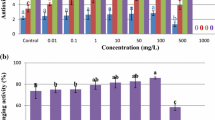Abstract
Tephrosia tinctoria, a perennial under shrub of Fabaceae family, is endemic to Western Ghats. In this study, friable whitish yellow callus was developed after 45 days using Murashige and Skoog medium supplemented with 2,4-dichlorophenoxyacetic acid (2.0 mg/l) + 6-benzylaminopurine (0.5 mg/l) in various explants of T. tinctoria. The ethyl acetate extracts of leaf (LE), stem (SE), and root (RE) were compared with leaf (LCE), stem (SCE), and root (RCE) derived callus, for antioxidant and antiproliferative activities. The SE possessed the highest phenolic and flavonoid content among all the extracts tested and showed a significant antioxidant assays. The study of anticancer activity on human hepatocellular carcinoma (HepG2) cell line revealed that the callus extracts especially RCE possessed significant inhibition of cell growth (IC50 20 μg/ml) at 72 h treatment period on analysis with MTT assay. The apoptotic cell death was observed through DNA fragmentation analysis in HepG2 cells treated with the T. tinctoria extracts. The gas chromatography–mass spectrometry finger printing profile showed that more than 60 % percentage of metabolites are similar in both SE and SCE. The higher percentage area of antioxidant compound (stigmast-4-en-3-one) was observed in SE (2.01 %) and higher percentage area of anticancer compound (phenol, 2,4-bis(1,1-dimethylethyl)) in SCE (0.91 %). In addition to that, callus extracts contain squalene, which is used for target deliver and also used as anticancer drug. Thus, the present study revealed that the T. tinctoria has potent antioxidant and antiproliferative activity and the callus culture can be used for the production of the bioactive compounds due to the endemic nature of this plant.










Similar content being viewed by others
References
Sherman, M. (2010). Seminars in Liver Disease, 30, 3–16.
Carr, C., Ng, J., & Wigmore, T. (2008). Current Anaesthesia and Critical Care, 19, 70–79.
Seifried, H. E., Anderson, D. E., Fisher, E. I., & Milner, J. A. (2007). The Journal of Nutritional Biochemistry, 18, 567–579.
Swamy, S. M. K., & Tan, B. K. H. (2000). Journal of Ethnopharmacology, 70, 1–7.
Gaskins, M.H., White, A.C., Martin, F.W., Delfel, N.E., Ruppel, E.G. & Barnes, D.K. (1972). Technical Bulletin, 1445.
Sarin, J. P. S., Singh, S., Garg, H., Khanna, N. M., & Dhar, M. M. (1976). Phytochemistry, 15(1), 232–234.
Chen, Y. L. (1978). Asian J Pharm, 3(4), 18.
Bentley, M. D., Hassanali, A., Lwande, W., Njoroge, P. E. W., & Yatagai, M. (1987). Insect Sci Appl, 8(1), 85–88.
Gokhale, A. B., & Saraf, M. N. (2000). Indian Drugs, 37, 12.
Thammanna, R., Narayana, K., & Madhava, C. K. (1994). Angiospermic wealth of Tirumala (p. 49). Tirupati: TTD.
Gulecha, V. & Sivakumar, T. (2011). Asian Pacific Journal of Tropical Medicine, 526–529.
Amin, I., Norazaidah, Y., & Emmy, H. K. I. (2006). Food Chemistry, 94, 47–52.
Meda, A., Lamien, C. E., Romito, M., Millogo, J., & Nacoulma, O. G. (2005). Food Chemistry, 91, 571–577.
Fan, Z., Wang, Z., & Liu, J. (2011). Food Chemistry, 129, 402–407.
Hua-Nan, L., Fei-Fei, N., Wei, L., Qin-Sheng, D., Na, L., Qi, Q., et al. (2009). Toxicology, 257, 80–85.
Alessandra, R., Venera, C., Laura, L., Luca, V., Angelo, V., & Juan, A. G. (2005). Journal of Ethnopharmacology, 100, 323–332.
Elumalai, S., Ramganesh, S., Prakasam, V., & Prabhakaran, M. (2011). J Advanced Laboratory Research in Biology, 2, 123–126.
Chao-Lin, K., Jun-Yi, C., Hung-Chi, C., Sushim, K. G., Hsiao-Sung, C., Emily, C. C., et al. (2011). Botanical Studies, 52, 285–294.
Hazeena, M. S., & Sulekha, G. R. (2008). Journal of Tropical Agriculture, 46(1–2), 79–84.
Huang, W. Y., Cai, Y. Z., & Zhang, Y. (2010). Nutrition and Cancer, 62(1), 1–20.
Gupta, S., & Prakash, J. (2009). Plant Foods for Human Nutrition, 64, 39–45.
Sies, H. (1993). Mutation Research, 299, 183–191.
Zhou, S. H., Fang, Z. X., Lu, Y., Chen, J. C., Liu, D. H., & Ye, X. Q. (2009). Food Chemistry, 112(2), 394–399.
Priyanka, S., Naresh, K., Utpal, B., & Rakhi, C. (2010). Biotechnology and Bioprocess Engineering, 15, 1038–1046.
Eschenfeldt, W. H., & Berger, S. L. (1987). Methods Enzymology, 152, 335–337.
Sakahira, H., Enari, M., & Nagata, S. (1998). Nature, 391, 96–99.
Sri, N., Abdul, M., Sim, K. S., Norhanom, A. W., & Hashim, Y. (2009). Molecules, 14, 1713–1724.
Ruby, L. A., Morrison, E. Y. S. A., & Muraleedharan, G. N. (2004). Phytotherapy Research, 18(5), 403–407.
Lakshmi, P. T. V., & Rajalakshmi, P. (2011). International research journal of pharmacy, 2(5), 247–249.
Senthilkumar, S., Devaki, T., Manohar, B. M., & Babu, M. S. (2006). Clinica Chimica Acta, 364, 335–342.
Fresco, P., Borges, F., Marques, M. P. M., & Diniz, C. (2010). Current Pharmaceutical Design, 16(1), 114–134.
Wu, S. J., Chang, S. P., Lin, D. L., Wang, S. S., Hou, F. F., & Ng, L. T. (2009). Food and Chemical Toxicology, 47, 1132–1138.
Acknowledgments
This study was financially supported by the Department of Science and Technology (SERC), India (sanction no. SR/FT/LS-043/2007).
Author information
Authors and Affiliations
Corresponding author
Rights and permissions
About this article
Cite this article
Rajaram, K., Moushmi, M., Velayutham Dass Prakash, M. et al. Comparative Bioactive Studies Between Wild Plant and Callus Culture of Tephrosia tinctoria Pers.. Appl Biochem Biotechnol 171, 2105–2120 (2013). https://doi.org/10.1007/s12010-013-0444-3
Received:
Accepted:
Published:
Issue Date:
DOI: https://doi.org/10.1007/s12010-013-0444-3




